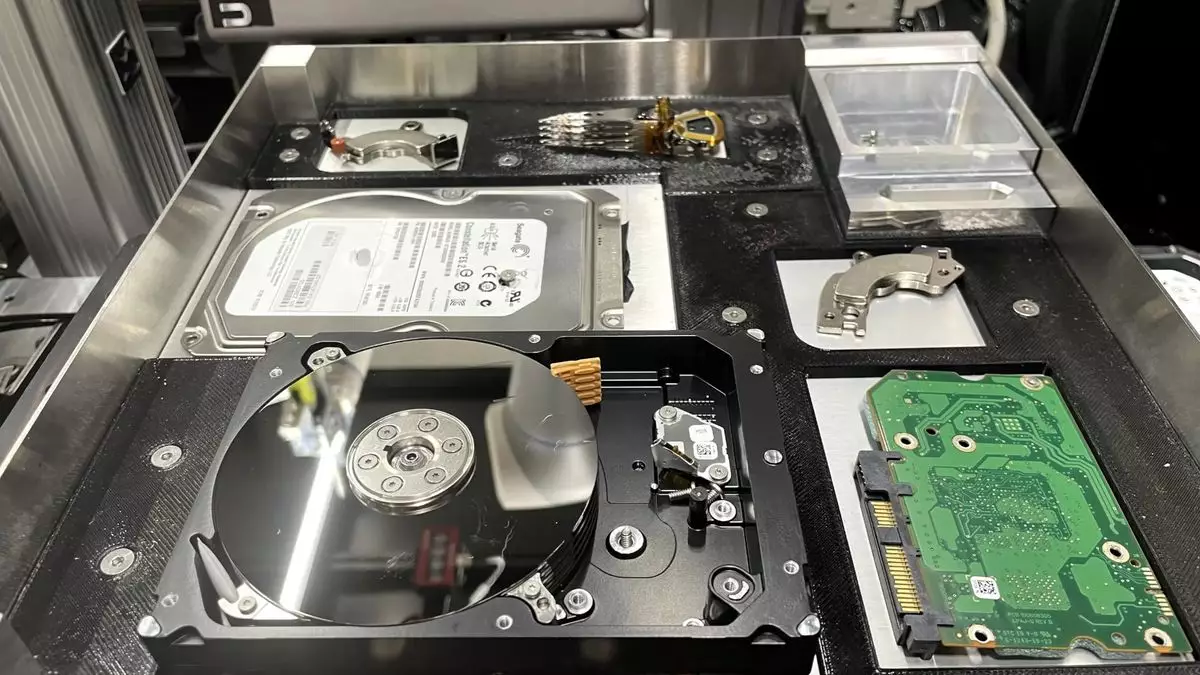In an age where technology is advancing rapidly, environmental concerns are increasingly coming to the fore. The global e-waste crisis is staggering, with data centers alone contributing an estimated 50 million metric tons of waste every year. A significant portion of this is attributed to defunct hard drives, which are often destroyed en masse to protect sensitive information. Fortunately, innovative solutions are emerging, with Microsoft leading the charge in exploring robotic technology for hard drive disassembly and recycling.
E-waste management presents a formidable challenge, especially for data centers where hard drives are regularly replaced to maintain operational efficiency. According to Microsoft, between 20 to 70 million hard drives are discarded annually, contributing to the growing mound of electronic refuse. The conventional method of shredding these drives destroys not only the data but also the valuable materials within. However, this method proves to be less than ideal when it comes to recycling efforts. The majority of materials are relegated to landfills or incineration, which exacerbates the environmental footprint tied to technology.
Recognizing the need for a better approach, Microsoft has embarked on a project aimed at revolutionizing how hard drives are disposed of and recycled. By integrating robots and artificial intelligence into the disassembly process, Microsoft aims to significantly increase the percentage of reused and recycled materials from hard drives—a goal set to be achieved by 2025.
The reliance on robots for disassembling hard drives offers a multitude of benefits. Unlike manual labor, which is subject to human error, robotic systems can efficiently handle the repetitive and monotonous aspects of disassembly, thereby enhancing productivity and precision. The project initiated by Ranganathan Srikanth, a principal data scientist at Microsoft, seeks to ensure a staggering 90% reclaim rate for all materials in hard drives. Utilizing machine learning, the robots can learn to identify various components within a hard drive and sort them accordingly.
Despite the noble aim, the path to fully realizing this vision is fraught with challenges. Hard drives, although similar in basic dimensions, contain various screws and components that need accurate identification. This intricate task requires extensive AI training to ensure the robots can consistently differentiate among the myriad parts. The initiative is still in its infancy, but the prototype displays promise for extensive future applications in e-waste management.
While the immediate focus is on hard drives, there is potential for this robotic recycling approach to extend to entire computers—laptops and desktop PCs included. The disassembly of these devices would be exponentially more complex, given their plethora of components and connections. Yet, the materials contained within these machines—such as metals, plastics, and circuits—are valuable and worth recovering, thereby justifying the complexity of the task. The success of the ongoing hard drive project could serve as a pilot for more extensive e-waste recycling strategies.
Admittedly, the term AI has become ubiquitous in discussions surrounding technology and sustainability, often leading to fatigue among audiences. However, the applications of AI in solving tangible environmental issues, such as hard drive disposal, can be refreshing and encouraging. Seeing technology employed to combat the e-waste crisis resonates deeply, particularly as our society grapples with its ecological responsibilities.
As society continues to consume technology at an unprecedented rate, the importance of sustainable solutions cannot be overstated. Microsoft’s initiative not only highlights the potential for robotic intervention in e-waste management but also serves as a call to action for other companies to follow suit. By leveraging cutting-edge technology, organizations can mitigate their environmental impact while also setting new standards for responsible waste disposal.
The transition to a more sustainable approach to e-waste recycling is not only feasible but also necessary. Establishing a robust framework for the recycling of electronic materials could have far-reaching implications, from enhancing resource recovery to bolstering public awareness about environmental responsibility. It remains imperative to continue exploring innovative solutions that prioritize both technology and sustainability, ensuring a cleaner, greener future for generations to come.

